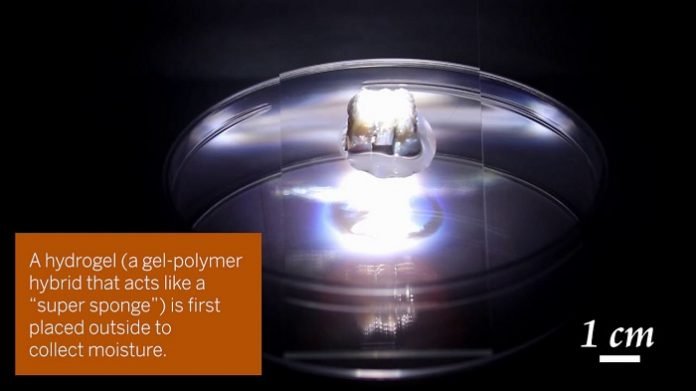
Currently, access to clean water remains one of the biggest challenges facing humankind.
But a new study from The University of Texas at Austin may offer a new solution using solar-powered technology.
The technology can absorb moisture from the air and returns it as clean, usable water.
It relies on hydrogels, gel-polymer hybrid materials designed to be “super sponges” that can retain large amounts of water.
The new technology builds upon a 2018 breakthrough made by the research team.
In that study, they worked a step further by using the water that already exists in the atmosphere.
They developed a solar-powered water purification innovation using hydrogels. The innovation could clean water from any source using only solar energy.
In the present study, the research team combined hydrogels that are both highly water absorbent and can release water upon heating.
This combination can successfully work in humid and dry weather conditions.
It is crucial to enabling the production of clean, safe drinking water from the air.
The new system is designed to both harvest moisture from the air and produce clean water under sunlight, avoiding intensive energy consumption
It is a completely passive system, meaning all people need to do is leave the hydrogel outside and it will collect water.
The collected water will remain stored in the hydrogel until people expose it to sunlight. After about five minutes under natural sunlight, the water releases.
The researchers suggest that this new system could tap into those reserves and potentially lead to small, inexpensive and portable filtration systems.
Harvesting water from moisture is not exactly a new concept. For example, most refrigerators keep things cool through a vapor condensation process.
However, the common fridge requires lots of energy to perform that action.
The new technology requires only solar power. It is compact and can still produce enough water to meet the daily needs of an average household.
The team’s prototype tests showed daily water production of up to 50 liters per kilogram of hydrogel.
The researchers suggest the new finding could be used in disaster situations, water crises or poverty-stricken areas and developing countries.
The study leader is by Guihua Yu in UT Austin’s Cockrell School of Engineering.
The study was published in a recent issue of the journal Advanced Materials.
Copyright © 2019 Knowridge Science Report. All rights reserved.



